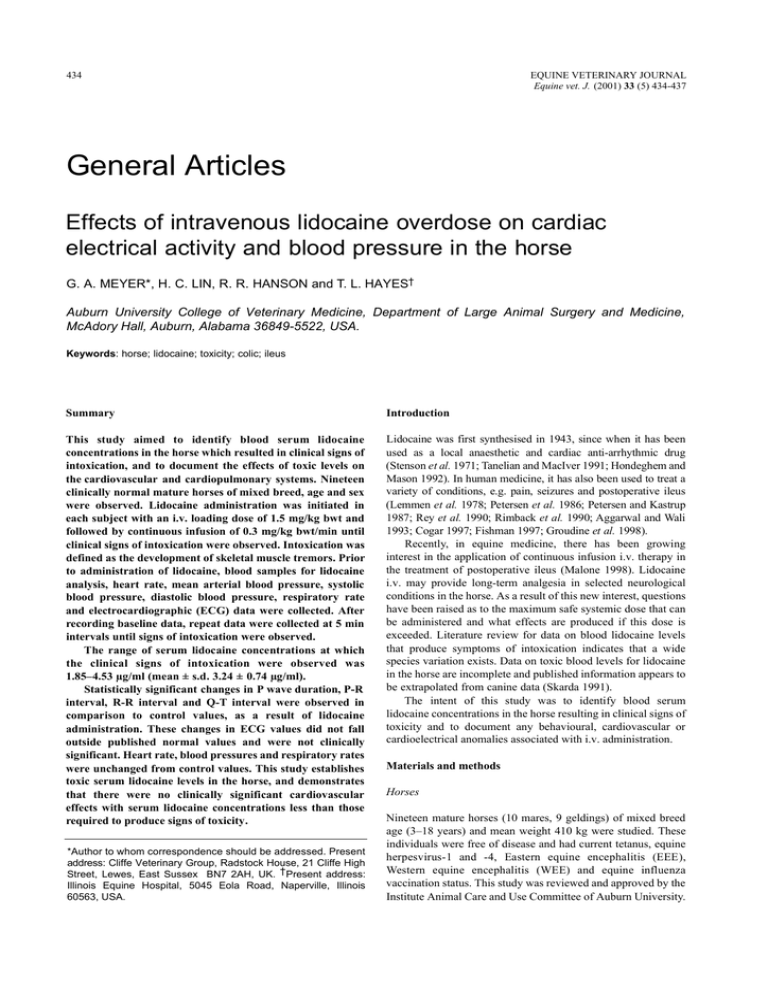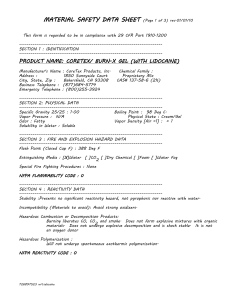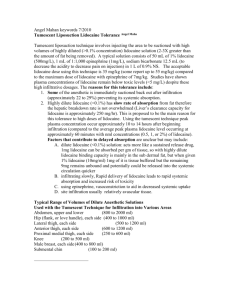Meyer GA, Lin HC, Hanson RR, Medlock TL. Effects of intravenous
advertisement

434 EQUINE VETERINARY JOURNAL Equine vet. J. (2001) 33 (5) 434-437 General Articles Effects of intravenous lidocaine overdose on cardiac electrical activity and blood pressure in the horse G. A. MEYER*, H. C. LIN, R. R. HANSON and T. L. HAYES† Auburn University College of Veterinary Medicine, Department of Large Animal Surgery and Medicine, McAdory Hall, Auburn, Alabama 36849-5522, USA. Keywords: horse; lidocaine; toxicity; colic; ileus Summary Introduction This study aimed to identify blood serum lidocaine concentrations in the horse which resulted in clinical signs of intoxication, and to document the effects of toxic levels on the cardiovascular and cardiopulmonary systems. Nineteen clinically normal mature horses of mixed breed, age and sex were observed. Lidocaine administration was initiated in each subject with an i.v. loading dose of 1.5 mg/kg bwt and followed by continuous infusion of 0.3 mg/kg bwt/min until clinical signs of intoxication were observed. Intoxication was defined as the development of skeletal muscle tremors. Prior to administration of lidocaine, blood samples for lidocaine analysis, heart rate, mean arterial blood pressure, systolic blood pressure, diastolic blood pressure, respiratory rate and electrocardiographic (ECG) data were collected. After recording baseline data, repeat data were collected at 5 min intervals until signs of intoxication were observed. The range of serum lidocaine concentrations at which the clinical signs of intoxication were observed was 1.85–4.53 µg/ml (mean ± s.d. 3.24 ± 0.74 µg/ml). Statistically significant changes in P wave duration, P-R interval, R-R interval and Q-T interval were observed in comparison to control values, as a result of lidocaine administration. These changes in ECG values did not fall outside published normal values and were not clinically significant. Heart rate, blood pressures and respiratory rates were unchanged from control values. This study establishes toxic serum lidocaine levels in the horse, and demonstrates that there were no clinically significant cardiovascular effects with serum lidocaine concentrations less than those required to produce signs of toxicity. Lidocaine was first synthesised in 1943, since when it has been used as a local anaesthetic and cardiac anti-arrhythmic drug (Stenson et al. 1971; Tanelian and MacIver 1991; Hondeghem and Mason 1992). In human medicine, it has also been used to treat a variety of conditions, e.g. pain, seizures and postoperative ileus (Lemmen et al. 1978; Petersen et al. 1986; Petersen and Kastrup 1987; Rey et al. 1990; Rimback et al. 1990; Aggarwal and Wali 1993; Cogar 1997; Fishman 1997; Groudine et al. 1998). Recently, in equine medicine, there has been growing interest in the application of continuous infusion i.v. therapy in the treatment of postoperative ileus (Malone 1998). Lidocaine i.v. may provide long-term analgesia in selected neurological conditions in the horse. As a result of this new interest, questions have been raised as to the maximum safe systemic dose that can be administered and what effects are produced if this dose is exceeded. Literature review for data on blood lidocaine levels that produce symptoms of intoxication indicates that a wide species variation exists. Data on toxic blood levels for lidocaine in the horse are incomplete and published information appears to be extrapolated from canine data (Skarda 1991). The intent of this study was to identify blood serum lidocaine concentrations in the horse resulting in clinical signs of toxicity and to document any behavioural, cardiovascular or cardioelectrical anomalies associated with i.v. administration. *Author to whom correspondence should be addressed. Present address: Cliffe Veterinary Group, Radstock House, 21 Cliffe High Street, Lewes, East Sussex BN7 2AH, UK. † Present address: Illinois Equine Hospital, 5045 Eola Road, Naperville, Illinois 60563, USA. Materials and methods Horses Nineteen mature horses (10 mares, 9 geldings) of mixed breed age (3–18 years) and mean weight 410 kg were studied. These individuals were free of disease and had current tetanus, equine herpesvirus-1 and -4, Eastern equine encephalitis (EEE), Western equine encephalitis (WEE) and equine influenza vaccination status. This study was reviewed and approved by the Institute Animal Care and Use Committee of Auburn University. 435 G. A. Meyer et al. 180 160 140 120 100 80 60 40 0 5 10 15 20 25 30 35 Time (min) 40 45 50 55 ◆ Sys BP; ▲ MAP; ■ Dias BP; ▲ Mean sys BP; ✕ Mean MAP; ● Mean dias BP 5.0 4.5 4.0 3.5 3.0 2.5 2.0 1.5 1.0 0.5 0.0 0 5 10 15 20 25 30 35 Administration (min) 40 45 50 Fig 3: Serum lidocaine concentrations that resulted in development of clinical signs of toxicity (Trial 2). Fig 1: Systemic arterial blood pressures during the course of i.v. lidocaine administration (Trial 2). Sys BP= systolic blood pressure; dias BP= Diastolic blood pressure; MAP = mean arterial pressure. 120 provide 0.3 mg lidocaine/kg bwt/min and administered until clinical signs of toxicity were observed. Trial 2: Lidocaine administration was initiated in each of the 19 subjects with continuous i.v. infusion of 2 mg/ml lidocaine solution, 0.3 mg lidocaine/kg bwt/min and administered until clinical signs of toxicity were observed. The 2 mg/ml lidocaine solution was compounded by adding 110 ml injectable 2% lidocaine hydrochloride solution to 1 litre balanced electrolyte solution1. This was administered by a calibrated i.v. fluid pump (LifeCare Model 4 Pump)1. 100 80 60 40 20 0 0 5 10 15 20 25 30 35 Time (min) 40 45 50 55 ■ Heart rate; ▲ Mean heart rate; ● Respiratory rate; ● Mean respiratory rate Fig 2: Heart and respiratory rates during the course of i.v. lidocaine administration (Trial 2). Experimental design Each horse in the study had one 14 gauge Teflon indwelling catheter (Abocath) 1 placed aseptically in each jugular vein, the left used for lidocaine administration and the right for blood sample collection. Prior to the administration of lidocaine HCL 2% solution1, blood samples for lidocaine analysis, arterial blood pressures, respiratory rate and ECG data were collected for utilisation as control values. After collection of baseline data, i.v. administration was started and repeat blood samples for further analysis and measurements of data collected at 5 min intervals until clinical signs of toxicity were observed, defined as the development of skeletal muscle fasciculation. Two separate trials involving all 19 horses were performed, using 2 different lidocaine administration regimens in each trial. Both administration regimens were calculated to produce a steady state blood lidocaine concentration of 5.73 µg/ml. A period of 14 days separated the 2 trials to ensure that there were no residual effects of the previous trial. Blood pressure: Blood pressure data were collected using a noninvasive oscillometric system (Dynamap)2. The inflatable cuff for the blood pressure measurement equipment was positioned at the base of the tail and centred over the coccygeal artery. Blood analysis: Blood samples were collected for lidocaine analysis in sterile glass blood collection tubes (Vacutainer)3 containing no anticoagulant. Within 6 h of collection, serum was separated by centrifugation, transferred into polypropylene vials (CryoTube: Nalgene)5 and frozen at -80°C until analysed. Lidocaine analysis was performed via high performance liquid chromatography (HPLC) (Nattel et al. 1979; Nution et al. 1979). ECG analysis: Data were collected in base-apex configuration and recorded on a paper strip chart at a rate of 50 mm/s. The recorded strip charts were measured manually and data digitised. P wave duration, P-R interval, QRS duration and Q-T interval data were analysed. Statistical analysis One way ANOVA was utilised to evaluate all ECG and cardiopulmonary data. Results Electrocardiogram (ECG) Trial 1: Lidocaine administration was initiated in each of the 19 subjects with a loading dose of 2% lidocaine i.v. 1.5 mg/kg bwt administered over a 3 min period, followed by continuous i.v. infusion of 2 mg/ml lidocaine solution, a rate calculated to In both Trials 1 and 2, ANOVA analysis of P wave duration (P = 0.02), P-R interval (P<0.001), Q-T interval (P<0.001) showed statistically significant variation throughout the course Effects of intravenous lidocaine overdose 436 of the study, but these values did not fall outside published normal ranges (Patterson 1996). QRS duration (P = 0.61) remained unchanged during the course of each study. Cardiopulmonary In both Trials 1 and 2, ANOVA analysis of mean arterial pressure (P= 0.5), systolic pressure (P= 0.42), diastolic pressure (P = 0.06), heart rate (P = 0.97) and respiratory rates (P = 0.59) were unchanged during the course of the study (Figs 1 and 2). Lidocaine concentration Serum lidocaine concentrations in Trial 2, at the point at which muscle fasciculations were observed, ranged between 1.85–4.53 µg/ml (mean ± s.d. 3.24 ± 0.74 µg/ml; Fig 3). ANOVA analysis of toxic lidocaine levels obtained from Trial 1 compared to Trial 2 showed no statistical difference between the 2 (P = 0.67); mean ± s.d. period for development of clinical signs of toxicity was 11.36 ± 5.52 min in Trial 1 and 33.12 ± 8.84 min in Trial 2. Behaviour In both trials, some alteration in behaviour was observed at the terminal stages of our tests. Two individuals displayed behaviour interpreted as alteration in visual function, of rapid but intermittent eye blinking, anxiety and attempts to inspect closely located objects. One individual developed rapid onset of severe ataxia and collapsed into sternal recumbency moments after the onset of eye blinking. This individual recovered within 10 min of stopping lidocaine administration and was able to rise and walk unassisted. Seven individuals appeared mildly sedated at the approximate midpoint of the test. The remaining individuals displayed no overt changes in behaviour. Discussion Serum lidocaine concentrations resulting in clinical signs of toxicity in our study were substantially lower than the 8 µg/ml level published previously (Skarda 1991). Toxicity studies in man and dogs produced muscle fasciculations at mean ± s.d. serum lidocaine concentrations of 1.56 ± 0.61 µg/ml and 8.21 ± 1.69 µg/ml, respectively (Wilcke et al. 1983; Wallace 1997) The findings of our study, in comparison to human and canine data, demonstrate the significant differences between species with regard to toxic lidocaine concentrations. Two separate trials were performed in this study with different lidocaine administration rates, because of concerns that the administration regimen applied in Trial 1 may have been too rapid. This proved to be unfounded. Overly rapid lidocaine administration rates can result in CNS stimulation related to exposure of the brain to lidocaine rather than a defined blood concentration (Scott 1986; Haasio et al. 1988). Although observed more quickly in Trial 1 than Trial 2, ANOVA analysis of blood lidocaine concentrations at which development of muscle fasciculations occurred were no different. In man, lidocaine has been shown to cause a dose-dependent arterial vasoconstriction at serum concentrations 10–102 ng/ml (Klein et al. 1968). In addition, it has been demonstrated in dogs that serum lidocaine concentrations approaching levels that produce CNS signs result in an increase in heart rate and a decrease in arterial blood pressure (Liu et al. 1980). The nonsignificant increases in blood pressure and heart rate observed in our study indicate that the equine cardiovascular system is not as sensitive to the effects of systemically administered lidocaine as other species. Our data also show that the nervous and/or musculoskeletal system of the horse is more sensitive to the effects of systemically administered lidocaine than is the cardiovascular system. It is unknown why one individual in this study developed rapid and profound ataxia that progressed to collapse. This individual was the oldest member in the study, age 15–18 years as determined by dental examination. It is well documented that lidocaine is metabolised in the liver and, in neonates, the elderly, or debilitated individuals, liver function can be impaired, resulting in elevated blood lidocaine levels developing over time. Because of the short duration of drug administration to this individual (10 min), it is unlikely that impaired hepatic clearance would have any effect in this situation. Serum lidocaine concentration in this subject at the time of collapse was 2.86 µg/ml, which was approximately median in values recorded. After the collapse of this individual, lidocaine administration was discontinued and the subject’s condition monitored. The subject maintained consciousness with no expression of seizure activity. Cardiovascular and cardiopulmonary anomalies were also not detected during the recovery period and, within 10 min of the discontinuation of lidocaine administration, the individual was able to rise and walk unassisted. This rapid recovery from the effects of lidocaine overdose is consistent with the author’s observations of overdose in clinical patients when administration errors have been made, and is compatible with the short 40 min half-life of lidocaine in the horse (Engelking et al. 1987). Lidocaine administration i.v. in man has been shown to result in changes in mentation, lightheadedness and visual and auditory disturbances (Hazra 1971; Liu et al. 1980; den Hartigh et al. 1993; Ueda et al. 1993; Haginomori et al. 1995; Shiomi et al. 1997a,b; Wallace 1997). The alterations in behaviour observed subjectively in several of our horses in the final stages of this study were consistent with these previously reported effects in man. This study establishes toxic serum lidocaine levels for the horse, and demonstrates that there are no clinically significant cardiovascular effects with serum lidocaine concentrations lower than those that result in signs of toxicity. The target steady state serum lidocaine level commonly used in clinical treatment of ileus in the horse is 0.98 µg/ml (Malone 1998; Meyer and Hanson 2000). This study indicates that the toxic threshold in the horse is 2–3 times the target therapeutic level used in the treatment of ileus in the horse. Manufacturers’addresses 1 Abbott Laboratories, North Chicago, Illinois, USA. Critikon, Inc; Tampa, Florida, USA. Becton Dickinson, Franklin Lakes, New Jersey, USA. 4 Cole-Parmer, Vernon Hills, Illinois, USA. 2 3 References Aggarwal, P. and Wali, J.P. (1993) Lidocaine in refractory status epilepticus: a forgotten drug in the emergency department. Am. J. Emerg. Med. 3, 243-244. Cogar, W.B. (1997) Intravenous lidocaine as adjunctive therapy in the treatment of decompression illness. Ann. Emerg. Med. 29, 284-286. Den Hartigh, J., Hilders, C.G., Schoemaker, R.C., Hulshof, J.H. and Vermeij, P. (1993) Tinnitus suppression by intravenous lidocaine in relation to its plasma concentration. Clin. Pharm. Therap. 54, 415-420. Engelking, L.R., Blyden, G.T., Lofsted, J. and Greenblatt, D.J. (1987) Pharmacokinetics of antipyrine, acetaminophen, and lidocaine in fed and fasted horses. J. vet. Pharmacol. Therap. 10, 73-82. Fishman, S.M.C. (1997) Intravenous lidocaine for treatment-resistant pruritus. Am. J. Med. 102, 584-585. G. A. Meyer et al. 437 Groudine, S.B., Fisher, H.A.G., Kaufman, R.P.J., Patel, M.K., Wilkins, L.J., Mehta, S.A. and Lumb, P.D. (1998) Intravenous lidocaine speeds the return of bowel function, decreases postoperative pain, and shortens hospital stay in patients undergoing radical retropubic prostatectomy. J. Urol. 160, 1599-1601. Petersen, P., Kastrup, J., Zeeberg, I. and Boysen, G. (1986) Chronic pain treatment with intravenous lidocaine. Neuro. Res. 8, 189-190. Haasio, J., Hekali, R. and Rosenberg, P.H. (1988) Influence of premedication on lignocaine-induced acute toxicity and plasma concentrations of lignocaine. Br. J. Anaesth. 61, 131-134. Rey, E., Radvanyi-Bouvet, M.F., Bodiou, C., Richard, M.O. and Olive, G. (1990) Intravenous lidocaine in the treatment of convulsions in the neonatal period: monitoring plasma levels. Therap. Drug Mon. 12, 316-320. Haginomori, S., Makimoto, K., Araki, M., Kawakami, M. and Takahashi, H. (1995) Effect of lidocaine injection on EOAE in patients with tinnitus. Acta Otolaryngol. 115, 488-492. Rimback, G., Cassuto, J. and Tollesson, P.O. (1990) Treatment of postoperative paralytic ileus by intravenous lidocaine infusion. Anesth. Analg. 70, 414-419. Hazra, J. (1971) The effects of intravenous lidocaine on optic evoked potentials in light and darkness. Anesth. 35, 384-393. Hondeghem, L.M. and Mason, J.W. (1992) Agents used in cardiac arrhythmias. In: Basic & Clinical Pharmacology, 5th edn., Ed: B.G. Katzung, Appleton & Lange, Norwalk. pp 190-210. Klein, S.W., Sutherland, R.I. and Morch, J.E. (1968) Hemodynamic effects of intravenous lidocaine in man. J.Can. med. Ass. 99, 472-475. Lemmen, L.J., Klassen, M. and Duiser, B. (1978) Intravenous lidocaine in the treatment of convulsions. J. Am. med. Ass. 239, 2025. Liu, P., Feldman, H. and Covino, B.G. (1980) Acute cardiovascular toxicity of lidocaine, bupivicaine and etidocaine in anesthetized, ventilated dogs. Anesth. 53, S231-S231. Malone, E. D. (1998) Intravenous lidocaine for the treatment of equine ileus. In: Proceedings of the 6th Equine Colic Research Symposium, University of Georgia-Athens, Georgia. p 42. Meyer, G.A. and Hanson, R.R. (2000) Nonstrangulating obstruction of the small intestine in the horse. Equine vet. Educ. 12, 150-159. Nattel, S., Rinkenberger, R.L., Lehrman, L.L. and Zipes, D.P. (1979) Therapeutic blood lidocaine concentrations after local anesthesia for cardiac electrophysiologic studies. N. Engl. J. Med. 301, 418-420. Nution, R.L., Peng, G.W. and Chiou, W.L. (1979) High performance liquid chromatographic methods for simultaneous determination of lidocaine and its N-dealkylated metabolites in plasma. J. Chromatogr. 162, 466-473. Patterson, M. (1996) Diagnostic aids in equine cardiology. In: Equine Cardiology, Blackwell Science, Oxford. pp 70-115. Petersen, P. and Kastrup, J. (1987) Dercum’s disease (adiposis dolorosa). Treatment of the severe pain with intravenous lidocaine. Pain 28, 77-80. Scott, D.B. (1986) Toxic effects of local anesthetic agents on the central nervous system. Br. J. Anaesth. 58, 732-735. Shiomi, Y., Funabiki, K., Naito, Y., Fujiki, N. and Tsuji, J. (1997a) The effect of intravenous lidocaine injection on hearing thresholds. Auris Nasus Larynx 24, 351-356. Shiomi, Y., Nagamine, T., Fujiki, N., Hirano, S., Naito, Y., Shibasaki, H. and Honjo, I. (1997b) Tinnitus remission by lidocaine demonstrated by auditoryevoked magnetoencephalogram: a preliminary report. Acta Otolaryngol. 117, 31-34. Skarda, R.T. (1991) Local anesthetics and local anesthetic techniques in horses. In: Equine Anesthesia - Monitoring and Emergency Therapy, Eds: W.M. Muir and J.A.E. Hubbell, Mosby Year Book, St. Louis. pp 199-246. Stenson, R.E., Constantino, R.T. and Harrison, D.C. (1971) Interrelations of hepatic blood flow, cardiac output, and blood levels of lidocaine in man. Circulation 63, 205-211. Tanelian, D.L. and MacIver, M.B. (1991) Analgesic concentrations of lidocaine suppress tonic A-delta and C fiber discharges produced by acute injury. Anesth. 74, 934-936. Ueda, S., Aso, S., Watanabe, Y. and Mizukoshi, K. (1993) Changes in auditory evoked responses during intravenous lidocaine. Acta Otolaryngol. 504, 89-93. Wallace, M.S.L. (1997) Concentration-effect relations for intravenous lidocaine infusions in human volunteers: Effects on acute sensory thresholds and capsaicin-evoked hyperpathia. Anesth. 86, 1262-1272. Wilcke, J.R., Davis, L.E. and Neff-Davis, C.A. (1983) Determination of lidocaine concentrations producing therapeutic and toxic effects in dogs. J. vet. Pharm. Therap. 2, 105-112.




